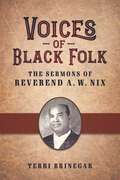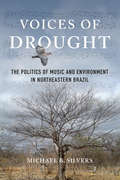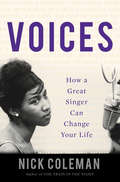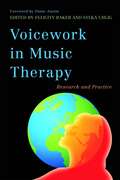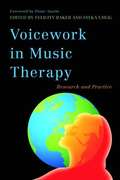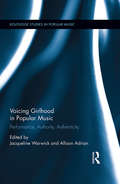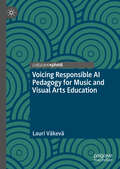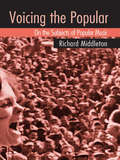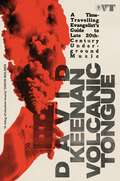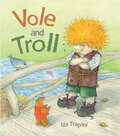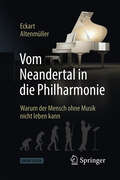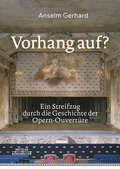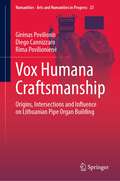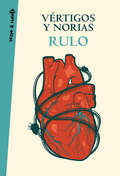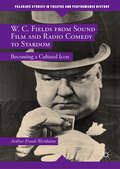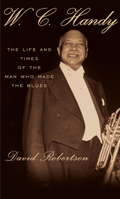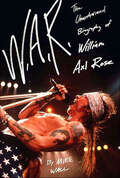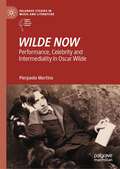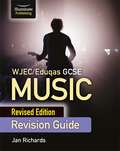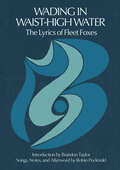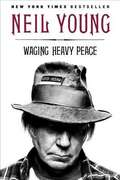- Table View
- List View
Voices of Black Folk: The Sermons of Reverend A. W. Nix (American Made Music Series)
by Terri BrinegarRecipient of a 2023 Certificate of Merit for Best Historical Research in Recorded Blues, R&B, Gospel, Hip Hop, or Soul Music from the Association for Recorded Sound CollectionsIn the late 1920s, Reverend A. W. Nix (1880–1949), an African American Baptist minister born in Texas, made fifty-four commercial recordings of his sermons on phonographs in Chicago. On these recordings, Nix presented vocal traditions and styles long associated with the southern, rural Black church as he preached about self-help, racial uplift, thrift, and Christian values. As southerners like Nix fled into cities in the North to escape the rampant racism in the South, they contested whether or not African American vocal styles of singing and preaching that had emerged during the slavery era were appropriate for uplifting the race. Specific vocal characteristics, like those on Nix’s recordings, were linked to the image of the “Old Negro” by many African American leaders who favored adopting Europeanized vocal characteristics and musical repertoires into African American churches in order to uplift the modern “New Negro” citizen. Through interviews with family members, musical analyses of the sounds on Nix’s recordings, and examination of historical documents and relevant scholarship, Terri Brinegar argues that the development of the phonograph in the 1920s afforded preachers like Nix the opportunity to present traditional Black vocal styles of the southern Black church as modern Black voices. These vocal styles also influenced musical styles. The “moaning voice” used by Nix and other ministers was a direct connection to the “blues moan” employed by many blues singers including Blind Willie, Blind Lemon, and Ma Rainey. Both Reverend A. W. Nix and his brother, W. M. Nix, were an influence on the “Father of Gospel Music,” Thomas A. Dorsey. The success of Nix’s recorded sermons demonstrates the enduring values African Americans placed on traditional vocal practices.
Voices of Drought: The Politics of Music and Environment in Northeastern Brazil
by Michael B. SilversIn Voices of Drought, Michael B. Silvers proposes a scholarship focused on environmental justice to understand key questions in the study of music and the environment. His ecomusicological perspective offers a fascinating approach to events in Ceará, a northeastern Brazilian state affected by devastating droughts. These crises have a profound impact on social difference and stratification, and thus on forró music in the sertão (backlands) of the region. At the same time, the complex interactions of popular music and social conditions also help create the environment. Silvers offers case studies focused on the sertão that range from the Brazilian wax harvested in Ceará for use in early wax cylinder sound recordings to the drought- and austerity-related cancelation of Carnival celebrations in 2014-16. Unearthing links between music and the environmental and social costs of drought, his daring synthesis explores ecological exile, poverty, and unequal access to water resources alongside issues like corruption, prejudice, unbridled capitalism, and expanding neoliberalism.
Voices of the Country: Interviews with Classic Country Performers
by Michael Streissguth"Voices of the Country" presents interviews with innovative musicians, producers, and songwriters who shaped the last fifty years of country music. From Eddy Arnold's new, smoother approach to song delivery to Loretta Lynn's take-no-prisoners feminism, these people opened new vistas in country music - and American culture. Streissguth is a sensitive and knowledgeable interviewer: he gets beyond the standard publicity tales to the heart of the real voice - and real experiences - of these important figures.
Voices: How a Great Singer Can Change Your Life
by nick Coleman"Voices isn't just illuminating and thought–provoking and clever; it is exciting." —Roddy Doyle, author of The CommitmentsA personal exploration of what singing means and how it works, Voices is a book about our deepest, most telling relationships with music. Nick Coleman examines the act of singing not as a performance, but as a close, difficult moment of hopeful connection. What does it do to us, emotionally and psychologically, to listen hard and habitually to somebody else’s singing? Why is human song so essential to our lives? The book asks many other questions, too: Why did Jagger and Lennon sing like that (and not like this)? Billie, Janis, Amy: must the voices of anguish always dissolve into spectacle? What makes us turn again and again to a singing human voice?The history of postwar popular music is often told sociologically or in terms of musicological influence and innovation in style. Voices offers a different, intimate perspective. In ten discrete but cohering essays, Coleman tackles the arc of that history as an emotional experience with real psychological consequences. He writes about the voices that have affected the ways he feels about and understands the world—from Aretha Franklin to Amy Winehouse, Marvin Gaye to David Bowie. Ultimately, Voices is the story of what it is to listen and be moved—what it is to feel emotion.
Voicework in Music Therapy
by Sylka Uhlig Edited by Felicity BakerThe voice is a powerful instrument in music therapy practice and this anthology of voicework techniques explores everything the practitioner and researcher needs to know in order to bring about successful vocal interventions across a broad range of client groups. Compiling a wealth of international evidence-based practice, this book offers detailed descriptions of clinical methods that are grounded in research. Chapters are grouped into structured and unstructured approaches for use with clients of all ages. Clinical populations covered include neonates, children with autism or developmental disability, individuals with neurological damage including stroke, Parkinson's disease patients, traumatic brain injury, and spinal injury, people with mental illness, medical conditions such as asthma and pain, oncology and palliative care, aged care and dementia. This book will be an invaluable resource for any music therapy student, practitioner or researcher looking to explore the use of voicework in music therapy.
Voicework in Music Therapy: Research and Practice
by Diane Austin Felicity Baker Sylka UhligThe authors bring together 16 chapters by a group of music therapy voicework specialists from North America, Europe, Asia, and Australia who describe to music therapy students, practitioners, and researchers voicework techniques for clients of all ages. They explain structured and free approaches to voicework with autistic and at-risk children; adults who were told as children they could not sing; newborns; individuals with emotional trauma, dementia, spinal cord injury, traumatic brain injury, neurological damage, Parkinson's disease, and aphasia or apraxia; and those in hospice or palliative care. Annotation ©2012 Book News, Inc. , Portland, OR (booknews. com)
Voicing Girlhood in Popular Music: Performance, Authority, Authenticity (Routledge Studies in Popular Music)
by Jacqueline Warwick Allison AdrianThis interdisciplinary volume explores the girl’s voice and the construction of girlhood in contemporary popular music, visiting girls as musicians, activists, and performers through topics that range from female vocal development during adolescence to girls’ online media culture. While girls’ voices are more prominent than ever in popular music culture, the specific sonic character of the young female voice is routinely denied authority. Decades old clichés of girls as frivolous, silly, and deserving of contempt prevail in mainstream popular image and sound. Nevertheless, girls find ways to raise their voices and make themselves heard. This volume explores the contemporary girl’s voice to illuminate the way ideals of girlhood are historically specific, and the way adults frame and construct girlhood to both valorize and vilify girls and women. Interrogating popular music, childhood, and gender, it analyzes the history of the all-girl band from the Runaways to the present; the changing anatomy of a girl’s voice throughout adolescence; girl’s participatory culture via youtube and rock camps, and representations of the girl’s voice in other media like audiobooks, film, and television. Essays consider girl performers like Jackie Evancho and Lorde, and all-girl bands like Sleater Kinney, The Slits and Warpaint, as well as performative 'girlishness' in the voices of female vocalists like Joni Mitchell, Beyoncé, Miley Cyrus, Taylor Swift, Kathleen Hanna, and Rebecca Black. Participating in girl studies within and beyond the field of music, this book unites scholarly perspectives from disciplines such as musicology, ethnomusicology, comparative literature, women’s and gender studies, media studies, and education to investigate the importance of girls’ voices in popular music, and to help unravel the complexities bound up in music and girlhood in the contemporary contexts of North America and the United Kingdom.
Voicing Responsible AI Pedagogy for Music and Visual Arts Education
by Lauri VäkeväThis book critically examines the integration of generative artificial intelligence (Gen AI) in music education, exploring its transformative potential and associated risks. It underscores the necessity for innovative AI pedagogies across music and the arts, offering educators, researchers, and policymakers valuable insights for incorporating Gen AI into teaching while mitigating its hazards. By adopting a balanced critical perspective, the book aims to promote a dynamic, inclusive, and responsible educational approach that is responsive to the rapid advancements in adaptive technology. The book's argumentation is grounded in synthesizing Deweyan pragmatist and Baradian posthumanist philosophical perspectives. These perspectives collectively provide a framework for addressing the deployment of Gen AI in music education within a broader ethical context of global sustainability. The book is also informed by the author's many years as a scholar of music education.
Voicing the Cinema: Film Music and the Integrated Soundtrack
by Hannah Lewis James BuhlerTheorists of the soundtrack have helped us understand how the voice and music in the cinema impact a spectator's experience. James Buhler and Hannah Lewis edit in-depth essays from many of film music's most influential scholars in order to explore fascinating issues around vococentrism, the voice in cinema, and music’s role in the integrated soundtrack. The collection is divided into four sections. The first explores historical approaches to technology in the silent film, French cinema during the transition era, the films of the so-called New Hollywood, and the post-production sound business. The second investigates the practice of the singing voice in diverse repertories such as Bergman's films, Eighties teen films, and girls' voices in Brave and Frozen. The third considers the auteuristic voice of the soundtrack in works by Kurosawa, Weir, and others. A last section on narrative and vococentrism moves from The Martian and horror film to the importance of background music and the state of the soundtrack at the end of vococentrism. Contributors: Julie Brown, James Buhler, Marcia Citron, Eric Dienstfrey, Erik Heine, Julie Hubbert, Hannah Lewis, Brooke McCorkle, Cari McDonnell, David Neumeyer, Nathan Platte, Katie Quanz, Jeff Smith, Janet Staiger, and Robynn Stilwell
Voicing the Popular: On the Subjects of Popular Music
by Richard MiddletonHow does popular music produce its subject? How does it produce us as subjects? More specifically, how does it do this through voice--through "giving voice"? And how should we understand this subject--"the people"--that it voices into existence? Is it singular or plural? What is its history and what is its future? Voicing the Popular draws on approaches from musical interpretation, cultural history, social theory and psychoanalysis to explore key topics in the field, including race, gender, authenticity and repetition. Taking most of his examples from across the past hundred years of popular music development--but relating them to the eighteenth- and nineteenth-century "pre-history"--Richard Middleton constructs an argument that relates "the popular" to the unfolding of modernity itself. Voicing the Popular renews the case for ambitious theory in musical and cultural studies, and, against the grain of much contemporary thought, insists on the progressive potential of a politics of the Low.
Volcanic Tongue: A Time-Travelling Evangelist’s Guide to Late 20th-Century Underground Music
by David KeenanVolcanic Tongue presents the first ever collection of multi-award-winning author David Keenan's music writings. Keenan has been writing about music since publishing his first fanzine, inspired by The Pastels and by Glasgow (and Airdrie's) DIY music scene, in 1988. Since then, he has written about music for Melody Maker, NME, Uncut, Mojo, The New York Times, Ugly Things, The Literary Review, The Social and, most consistently, The Wire. Volcanic Tongue was also the name of the record shop and mail order that Keenan ran with his partner, Heather Leigh, in Glasgow from 2005-2015.Volcanic Tongue features the best of his reviews, interviews and think pieces, with exclusive in-depth conversations between Keenan and Nick Cave, members of legendary industrial bands Coil and Throbbing Gristle, krautrock legends like Faust, Shirley Collins, the first lady of English folk, Kevin Shields of My Bloody Valentine, German auto-destructives Einstürzende Neubauten, as well as discographical analysis of the back catalogues of groups like Sonic Youth and musicians like John Fahey, extensive writings on free jazz and obsessive in-depth digs into favourites like Pere Ubu, Metal Box-era Public Image Ltd, Sun Ra, guitarist and vocalist John Martyn and many more. It is an essential addition to any music fan's bookshelf.This first collection of his legendary criticism functions as an extended love letter to the revolutionary music of the 20th century and the incredible culture that sustained it.
Volcanic Tongue: A Time-Travelling Evangelist’s Guide to Late 20th-Century Underground Music
by David KeenanVolcanic Tongue presents the first ever collection of multi-award-winning author David Keenan's music writings. Keenan has been writing about music since publishing his first fanzine, inspired by The Pastels and by Glasgow (and Airdrie's) DIY music scene, in 1988. Since then, he has written about music for Melody Maker, NME, Uncut, Mojo, The New York Times, Ugly Things, The Literary Review, The Social and, most consistently, The Wire. Volcanic Tongue was also the name of the record shop and mail order that Keenan ran with his partner, Heather Leigh, in Glasgow from 2005-2015.Volcanic Tongue features the best of his reviews, interviews and think pieces, with exclusive in-depth conversations between Keenan and Nick Cave, members of legendary industrial bands Coil and Throbbing Gristle, krautrock legends like Faust, Shirley Collins, the first lady of English folk, Kevin Shields of My Bloody Valentine, German auto-destructives Einstürzende Neubauten, as well as discographical analysis of the back catalogues of groups like Sonic Youth and musicians like John Fahey, extensive writings on free jazz and obsessive in-depth digs into favourites like Pere Ubu, Metal Box-era Public Image Ltd, Sun Ra, guitarist and vocalist John Martyn and many more. It is an essential addition to any music fan's bookshelf.This first collection of his legendary criticism functions as an extended love letter to the revolutionary music of the 20th century and the incredible culture that sustained it.
Vole and Troll
by Iza TrapaniLoosely based on "The Three Billy Goats Gruff," this sweet, funny tale introduces two loveable characters who just can't get along . . . until they start singing.Troll-dee-roll, I'm a troll, and my favorite food is vole.Meet mischievous Vole and grouchy old Troll, the newest characters by best selling author/illustrator Iza Trapani. Vole wants to cross the bridge to where the literal and proverbial grass is greener, but grumpy old Troll lives under the bridge and offers two options: pay the toll or eat Vole. Vole outwits Troll three times by distracting him with clever, interactive songs (which will be quite familiar to young children and caregivers). But in the end, the pair lays aside their differences and embraces their common love of music.
Vom Neandertal in die Philharmonie: Warum der Mensch ohne Musik nicht leben kann
by Eckart AltenmüllerWarum haben wir Menschen Musik? Wie entfaltet Musik ihre Wirkung? Was geht dabei in unserem Gehirn vor? Fördert Musik die Intelligenz? Dient sie dem Gruppenzusammenhalt? Teilt Musik Emotionen mit? Dieses Buch erklärt die zahlreichen Wirkungen von Musik auf Fühlen und Denken, auf die Organisation von Gruppen sowie auf unsere körperliche und geistige Gesundheit. Im ersten Teil des Werkes werden die evolutionären Grundlagen der Musikwahrnehmung und des Musizierens dargestellt. Die faszinierenden neuen Erkenntnisse zu den positiven, aber auch den negativen Auswirkungen intensiven Musizierens auf das Nervensystem werden in den folgenden Kapiteln geschildert. Glücklicherweise macht Musik nur selten krank – viel wichtiger sind die bislang noch gar nicht ausgeschöpften heilenden Potenziale und die große Macht der positiven Emotionen, die durch Musik ausgelöst werden. Mit diesen erfreulichen und zukunftsweisenden Aspekten schließt das Buch, das jeden ansprechen wird, der eine Liebe zur Musik empfindet, sei es als Musizierender oder als Hörer.
Vorhang auf?: Ein Streifzug durch die Geschichte der Opern-Ouvertüre
by Anselm GerhardDie Ouvertüre gehört zur Oper wie der Spitzenton in der höchsten Sopran- oder Tenor-Lage. Sollte man meinen. Dabei beginnt längst nicht jede Oper mit einer Ouvertüre. Dieses Buch beschreibt Erscheinungsformen und Funktionen der instrumentalen Einleitung im Musiktheater vom Barock bis in die Moderne. Der Blick ist dabei auf den Zusammenhang zwischen Eröffnungsmusik und Bühnenhandlung gerichtet, auf etwas, was in der Frühzeit der Oper gerade nicht angestrebt worden war, sich dann aber Schritt für Schritt entwickelte. So erzählt das Buch viele unbekannte Geschichten von konventionellen und vor allem unkonventionellen Lösungen, wie eine Oper eröffnet und ein Publikum zur Aufmerksamkeit gerufen wurde. Schon im 18. Jahrhundert gab es beispielsweise Pantomimen bei geöffnetem Vorhang – und zwar lange bevor ‚moderne‘ Opernregie solche Aktionen traditionellen Ouvertüren hinzuerfinden sollte. Auch davon ist, in einem Bogen von Monteverdis „Orfeo“ bis zu Brittens „Owen Wingrave“, die Rede.
Vox Humana Craftsmanship: Origins, Intersections and Influence on Lithuanian Pipe Organ Building (Numanities - Arts and Humanities in Progress #23)
by Rima Povilionienė Girėnas Povilionis Diego CannizzaroThis book provides a thorough analysis focused on the sound expression produced by human-crafted musical instrument – a pipe organ, in which various components blend into a complex whole to produce a wide range of timbres. The sound produced by wooden and metal pipes of a variety of sizes is an integral part of the instrument’s unique character, while the organ stop is like its signature, from which one can judge about the size and style of the instrument, an organ building school or even an organ master, to which it is attributable. Precise identification of the name of the stop in accordance to both the pipework itself and the authentic inscriptions on the pipes is instrumental in investigating the geographic origins and authorship of an organ. The monograph focuses on the craftsmanship of complex and historically influential organ stop Vox humana. Its research and definition provides specific information distinguishing particular features in the variety of organ building traditions and discussing the differences in organ sound perception and production. The volume is aimed at art and music historians, as well as musicologists and scholars researching restoration techniques.The book contains supplemental material with video and audio material as well as photo-documentation of authentic Vox humana examples. The material is placed in the online catalog, which may be accessed by scanning the QR code in the appendix of the book.dsgdsgds
Vértigos y norias
by RuloRulo se atreve por primera vez a ir más allá del universo de sus letras musicales y nos abre las puertas a su mundo interior a través de este libro repleto de textos, poemas y reflexiones. «La infancia es ese hogar que nunca podrás deshabitar». No somos más que niños en un parque de atracciones, un cúmulo de vértigos y norias, una aventura desordenada a la que a veces le falta argumento y otras le sobran giros de guion. Pero en ese imprevisto juego de azar está la gracia: sentir es un deporte de riesgo en el que no hay medidas de seguridad. Estas páginas componen un dibujo perfecto de esa apuesta que es vivir, de esa carrera de obstáculos que es latir cada día, de esa nostalgia y ese deseo que nos hacen caminar hacia delante sin olvidar el laberinto que nos trajo hasta aquí. En este libro, Rulo, cantante, compositor y uno de los grandes exponentes del rock español de las últimas décadas, se atreve por primera vez a ir más allá del universo de sus letras musicales y nos abre las puertas a su mundo interior a través de una gran variedad de textos, poemas y reflexiones fruto de sus experiencias y anécdotas rodadas a lo largo de miles de kilómetros con su furgoneta y tras los escenarios.
W. C. Fields from Sound Film and Radio Comedy to Stardom: Becoming a Cultural Icon (Palgrave Studies in Theatre and Performance History)
by Arthur Frank WertheimW. C. Fields is known as a virtuoso comedian and legendary iconoclast who gave the gift of laughter to multitudes. As the first author to use the newly-opened Fields Papers at the Academy library, Arthur Frank Wertheim illuminates the comedian’s arduous ascent to stardom during Hollywood's golden age. The book reveals details of Fields’s turbulent private life, from his wife's refusal to divorce, to his estranged son, and to his fleeting relationships with women. Here is a portrait of an aggrieved artist whose emotional anguish found refuge in his poignant comedy about life’s frustrations and the human condition. This third volume in Wertheim's trilogy documents Fields's rise to iconic status during the counterculture 1960s, creating a legacy of his comedy for generations to come.
W. C. Handy: The Life and Times of the Man Who Made the Blues
by David RobertsonBefore there was Elvis, there was W. C. Handy, "the man who made the blues. " Here is the first major biography in decades of the man who produced iconic songs and who was responsible, more than any other musician, for bringing the blues into the American mainstream.
W.A.R.: The Unauthorized Biography of William Axl Rose
by Mike WallA biography that “captures the runaway-train spirit” of Guns N’ Roses singer Axl Rose and delves into what shaped him as a man and a musician (Kirkus Reviews).Even in the world of rock and roll, someone like Axl Rose doesn’t come along very often. Mercurial and brilliant, deluded and imperious, Rose defies easy description or analysis. Few people have studied Rose as closely as Mick Wall has. Traveling with Guns N’ Roses and writing about them in the late 1980s and early 1990s, Wall first earned Axl’s trust and later his fury.W.A.R. goes back to the beginning, revealing Rose’s childhood influences (and how he got his name), and tracking the birth of the band and their enormous success with albums like Appetite for Destruction and Use Your Illusion. With fame and money came substance abuse and infighting, and a lead singer who morphed from eccentric to seemingly unhinged.Wall’s book is richly detailed and offers surprising new views of a variety of Guns N’ Roses and Axl Rose incidents, including the death of two fans at a concert in England; Rose’s eventual split from every one of the other original band members; fights with perceived enemies like Kurt Cobain, Motley Crue’s Vince Neil and fashion designer Tommy Hilfiger; Rose’s refusal to show up at concerts throughout his career; and his many years as a virtual recluse at his Malibu mansion. W.A.R. is about great music, bad relationships, and the public and private personas of one of the most controversial performers of our time.“The best rock biography that has ever landed on my desk . . . turns the story of Axl Rose . . . into a profound examination of the pain of fame.” —The Tribune (UK)“A catalog of lawsuits, sackings, and all-round appalling behavior.” —The Daily Telegraph (UK)“It’s easy to paint Rose as a wrathful tyrant, but Wall has you sympathizing with [him].” —Entertainment Weekly
WILDE NOW: Performance, Celebrity and Intermediality in Oscar Wilde (Palgrave Studies in Music and Literature)
by Pierpaolo MartinoWILDE NOWreads Oscar Wilde through our now, through a contemporary sensibility (and approach), in which literature and popular culture interrogate and are interrogated by critical concepts and categories such as performance, celebrity, intermediality, and consumerism. This volume exceeds the shape and meaning of a critical study to turn into a drama of five different acts/moments in Wilde’s life and work: his early performances in Dublin, London and Oxford; the 1882 American tour; his successful season of the first half of the 1890s, his prison years and finally his glorious resurrection in contemporary pop culture. Most importantly WILDE NOW approaches these moments through contemporary rewritings and performances of “Oscar Wilde” in the fields of cinema, music and literature by such artists as Al Pacino, Rupert Everett, Stephen Fry, Gyles Brandreth, David Hare, David Bowie, Morrissey, Nick Cave, Neil Tennant, Gavin Friday. These artists – through their awareness of the importance of being/playing Oscar in their specific worlds and cultural contexts – will also show us that Wilde can be conceived as a subversive, critical role one might successfully perform and appropriate, now more than ever.
WJEC/Eduqas GCSE Music Revision Guide - Revised Edition
by Jan RichardsThe Revised Edition covers the WJEC/Eduqas amended GCSE Music specifications for first teaching from September 2020. // This revised edition covers the new prepared extracts in Unit 3 (WJEC) and Component 3 (Eduqas) for assessment from summer 2022: WJEC: Peer Gynt Suite No.1: Anitra's Dance: Grieg, Everything Must Go: Manic Street Preachers // Eduqas: Badinerie by J.S.Bach for Flute and String Orchestra with Harpsichord, Africa: Toto // This practical and concise revision guide is designed to support students preparing for their WJEC and Eduqas GCSE Music assessment. // Provides the necessary musical information in a succinct and accessible format, ensuring students are fully equipped for assessment // Offers students the opportunity to practise identifying the elements of music when listening, and how they are used in composing // Highlights the required Musical Terms with definitions and includes plenty of Practice Questions to assist students in developing their musical theory skills // Provides help and advice on how to approach the listening examination and coursework // Contains Sample Exam Questions with example answers and commentaries to demonstrate ways to approach the exam aspect of the course // Free audio clips and web links to music to accompany this book will be provided via a dedicated website. 'Listening' icons alongside relevant sections within the book indicate when to go online.
WJEC/Eduqas GCSE Music Student Book: Revised Edition
by Jan RichardsThe Revised Edition of this popular Student Book covers the WJEC/Eduqas amended GCSE Music specifications for first teaching from September 2020. // This revised edition covers the new prepared extracts in Unit 3 (WJEC) and Component 3 (Eduqas) for assessment from summer 2022: WJEC, Peer Gynt Suite No.1: Anitra's Dance: Grieg, Everything Must Go: Manic Street Preachers, Eduqas, Badinerie by J.S.Bach for Flute and String Orchestra with Harpsichord Africa: Toto // Endorsed by WJEC // Covers all four Areas of Study: Musical Forms and Devices, Music for Ensemble, Film Music and Popular Music // Provides practical activities, extension tasks, suggestions for additional listening and useful tips for individual and group work // Supports students in all aspects of Performing, Composing and Appraising // Helps students prepare for the Performing Assessment and presentation of their coursework for Composing: includes identifying best practice, practical advice and guidance on how to complete the required log, evaluation and programme notes // Free audio clips and web links to music performances to accompany this book are provided via a dedicated website. 'Listen online' icons alongside relevant sections within the book indicate when to go online.
Wading in Waist-High Water: The Lyrics Of Fleet Foxes
by Robin PecknoldA Vulture Most Anticipated Book of Fall A Powell's Holiday Pick for 2022 “There is something quite moving about seeing these fifty-five songs collected and assembled this way. Themes of family, friendship, love, destiny, loss, nature, and honest living bridge all of the albums and form the core set of concerns of this body of work. At the same time, you can see the evolution of the minds and hearts at work behind the lyrics.” —Brandon Taylor Since the release of their breakout debut album in 2008, Fleet Foxes and their front man, singer-songwriter Robin Pecknold, have enjoyed international critical and commercial acclaim. Their music has helped reshape the American indie-folk sound through songs that are acoustically and melodically driven, steeped in gospel-like harmonies, and propelled by Pecknold’s resonant, earthy, and timeless lyrics. Wading in Waist-High Water: The Lyrics of Fleet Foxes contains Pecknold’s complete lyrics from fifty-five songs, capturing the poetic and inventive storytelling that is a hallmark of the band’s music. These richly layered lyrics explore the complexity, darkness, and beauty of physical and emotional landscapes, both pastoral and modern. Accompanying the lyrics, Pecknold includes notes on his creative processes, inspirations, and motivations. With an introduction by celebrated novelist Brandon Taylor, and an afterword by Pecknold, Wading in Waist-High Water is a moving and intimate look at the art of songwriting, the joy of music-making, and what it means to produce meaningful and memorable sound.
Waging Heavy Peace
by Neil YoungThis beautiful limited edition will be signed by Neil Young and repackaged in a slip case and linen cover. Only 1,500 copies will be printed, making it an essential addition to every music lover’s collection. For the first time, legendary singer, songwriter, and guitarist Neil Young offers a kaleidoscopic view of his personal life and musical creativity. He tells of his childhood in Ontario, where his father instilled in him a love for the written word; his first brush with mortality when he contracted polio at the age of five; struggling to pay rent during his early days with the Squires; traveling the Canadian prairies in Mort, his 1948 Buick hearse; performing in a remote town as a polar bear prowled beneath the floorboards; leaving Canada on a whim in 1966 to pursue his musical dreams in the pot-filled boulevards and communal canyons of Los Angeles; the brief but influential life of Buffalo Springfield, which formed almost immediately after his arrival in California. He recounts their rapid rise to fame and ultimate break-up; going solo and overcoming his fear of singing alone; forming Crazy Horse and writing “Cinnamon Girl,” “Cowgirl in the Sand,” and “Down by the River” in one day while sick with the flu; joining Crosby, Stills & Nash, recording the landmark CSNY album, Déjà vu, and writing the song, “Ohio;” life at his secluded ranch in the redwoods of Northern California and the pot-filled jam sessions there; falling in love with his wife, Pegi, and the birth of his three children; and finally, finding the contemplative paradise of Hawaii. Astoundingly candid, witty, and as uncompromising and true as his music, Waging Heavy Peace is Neil Young’s journey as only he can tell it. .
